 Experimental aviation, full of trendsetters and outliers though it definitely is, often follows a predictable path. Companies come and companies go. Aircraft designs are born, succeed, evolve, die. Tastes change in our world, though, and it should be noted, the overall gravity of Van’s Aircraft’s success creates both an expectation of supply and support, but also can influence development plans. No doubt Experimental aviation today is a mature field, less full of wild-eyed inventors and more occupied by kit- and plans-supplying companies refining their products and business plans in equal measure. Homebuilders expect.
Experimental aviation, full of trendsetters and outliers though it definitely is, often follows a predictable path. Companies come and companies go. Aircraft designs are born, succeed, evolve, die. Tastes change in our world, though, and it should be noted, the overall gravity of Van’s Aircraft’s success creates both an expectation of supply and support, but also can influence development plans. No doubt Experimental aviation today is a mature field, less full of wild-eyed inventors and more occupied by kit- and plans-supplying companies refining their products and business plans in equal measure. Homebuilders expect.
Which brings us here. The Glasair Aviation Sportsman you see on these pages might just be a unicorn. It exemplifies a recent burst of development on the design—whose roots date back to the GlaStar of 1994—but is an airplane that, as a practical matter, you can’t actually buy. As this is written, Glasair Aviation has hit the “pause” button, laying off its production staff, taking no new orders and halting work at its Two Weeks to Taxi builder-assist facility—the last item just one side effect of COVID-19 social-distancing restrictions. It’s retaining a small support and engineering staff with an eye toward relaunching in 2021 with a substantially revised product. For more on the business side of the matter, see my editorial “Radical Reconstruction.”
Since the launch of Two Weeks to Taxi in 2006, the company has focused on that program and continued to develop the kit to be a better fit there, which meant de-prioritizing the Sportsman as a more traditional build-it-at-home kit. In recent years, TWTT-completed airplanes outnumber those built in garages and basements by a wide margin. That may or may not continue to be the case as the company reintroduces the model with what it says will be significant improvements. Some of those they hinted at with me, some they wouldn’t talk about, but I was given enough of a briefing to understand where the company is trying to take the design and can guess, because of my experience with the Sportsman, how it might go about reaching those goals.
Why Are We Here?
It’s a fair question to wonder why we’re featuring an airplane you can’t buy today. The answers are actually pretty simple. The basic design is not going to change in fundamental ways—the wing stays on top, the tail stays at the back and steel tubes remain inside a composite fuselage shell to support aluminum wings. When it returns, the Sportsman will still be convertible to both tri-gear and taildragger configurations, as well as going onto floats. There’s actually another reason to check in with the circa-2020 Sportsman: The company has upgraded several aspects of the Sportsman since we last flew it—and radically so since I last flew mine in 2011—all of which will carry over into the new version.
From the outside, not a lot has appeared to change, but what does stand out is the superlative paint job on the factory demo, which is said to be representative of the paint-shop capabilities that Randy Lervold, recently hired as Glasair Aviation’s CEO, has worked hard to implement. Indeed, paint had been a sticking point, so to speak, on the TWTT aircraft. Early versions left it to the builder to source painting, though the program evolved into referring builders to local resources and then managing that part of the program for the builder in the most recent examples. Lervold told me that painting and overall detail wrap-up were among the most time-consuming steps in the build. Getting the Sportsman from a rack full of parts to something ready to start up and taxi in a couple of weeks is easy compared to finding a good painter, or so it seems.
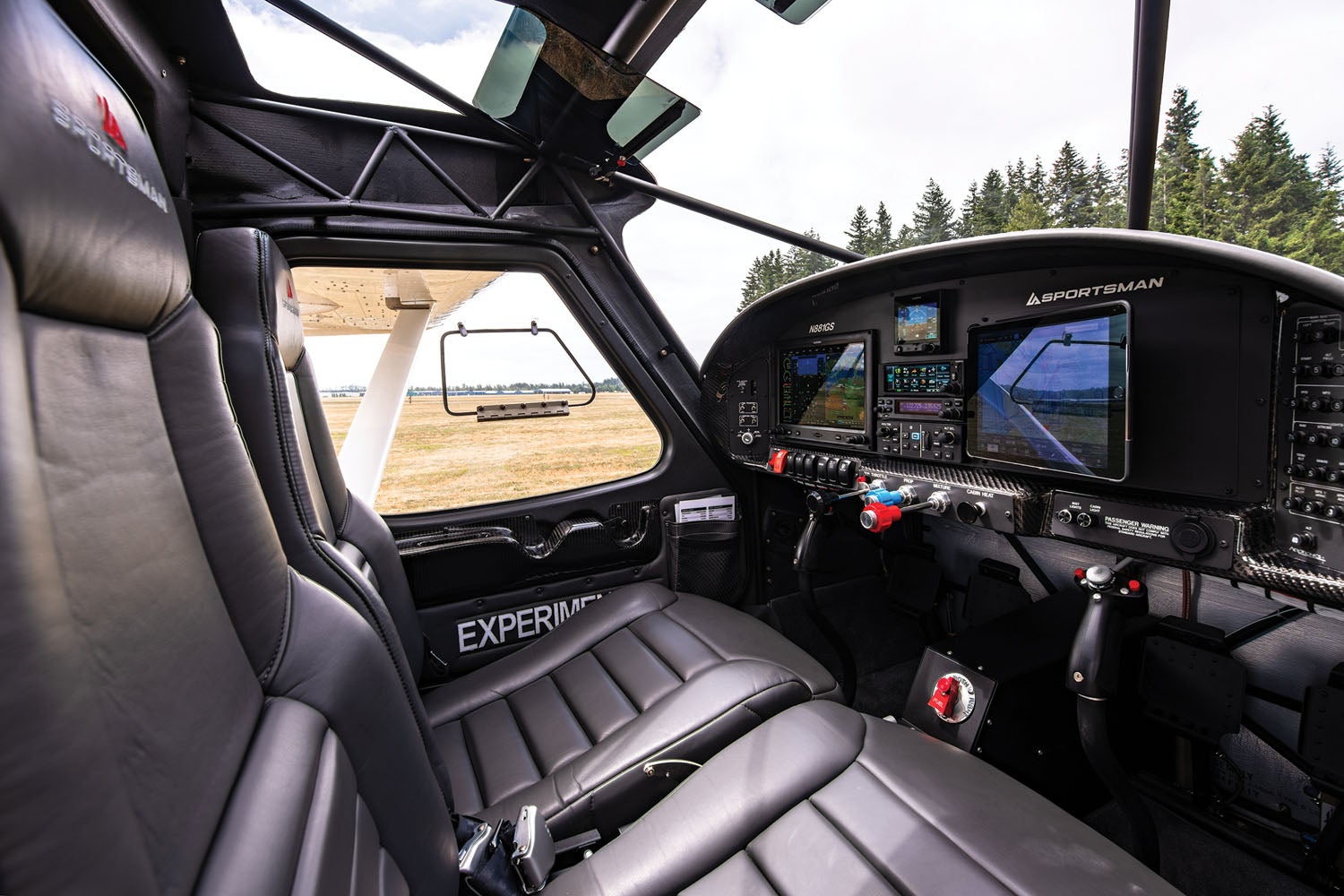
Changes to the Sportsman’s interior are startling. Where they were typically all gray inside, sometimes described as an “Arlington bass boat,” the 2020 Sportsman is all cool, broody tones. The steel-tube fuselage cage is a deep gray, the seats are nearly black, the glareshield is larger and dark and the combination of carbon-fiber panels and accents gives the Sportsman the feel of a production airplane. (Yes, that’s a compliment.) The seat cushions are reshaped, sumptuous and AmSafe airbag seatbelts are a $2895 option.
You old-time builders are rolling your eyes, thinking that interiors ought to be light, functional and cheap. Traditional aesthetics amount to rounding off the sharp edges, dabbing paint on a few screw heads and moving on. But don’t forget that the price level where the Sportsman lives includes spousal buy-in. Non-pilot family members take interior quality and comfort seriously.
Current Thinking
Today’s Sportsman panel is an evolution of the first fiberglass “molded” panels that started back in the two-seat GlaStar days. But, now, it’s made of carbon fiber and lacks the segmentations that used to denote conventional radio racks. Today’s airplane has one large panel populated, in this case, with a 10-inch Garmin G3X Touch on the left, a GPS 175 IFR GPS, GTR 200 com radio, G5 backup EFIS and GMC 507 autopilot controller in the center. A remote-mount transponder rounds out this airplane’s avionics. It’s worth noting that the right side of the panel (covered by ay iPad in these photos) has a cutout for a second G3X Touch screen and is already wired; it’s fairly trivial to upgrade to a second screen if you want. As someone living through rolling avionics upgrades, I can tell you this is not an insignificant detail.
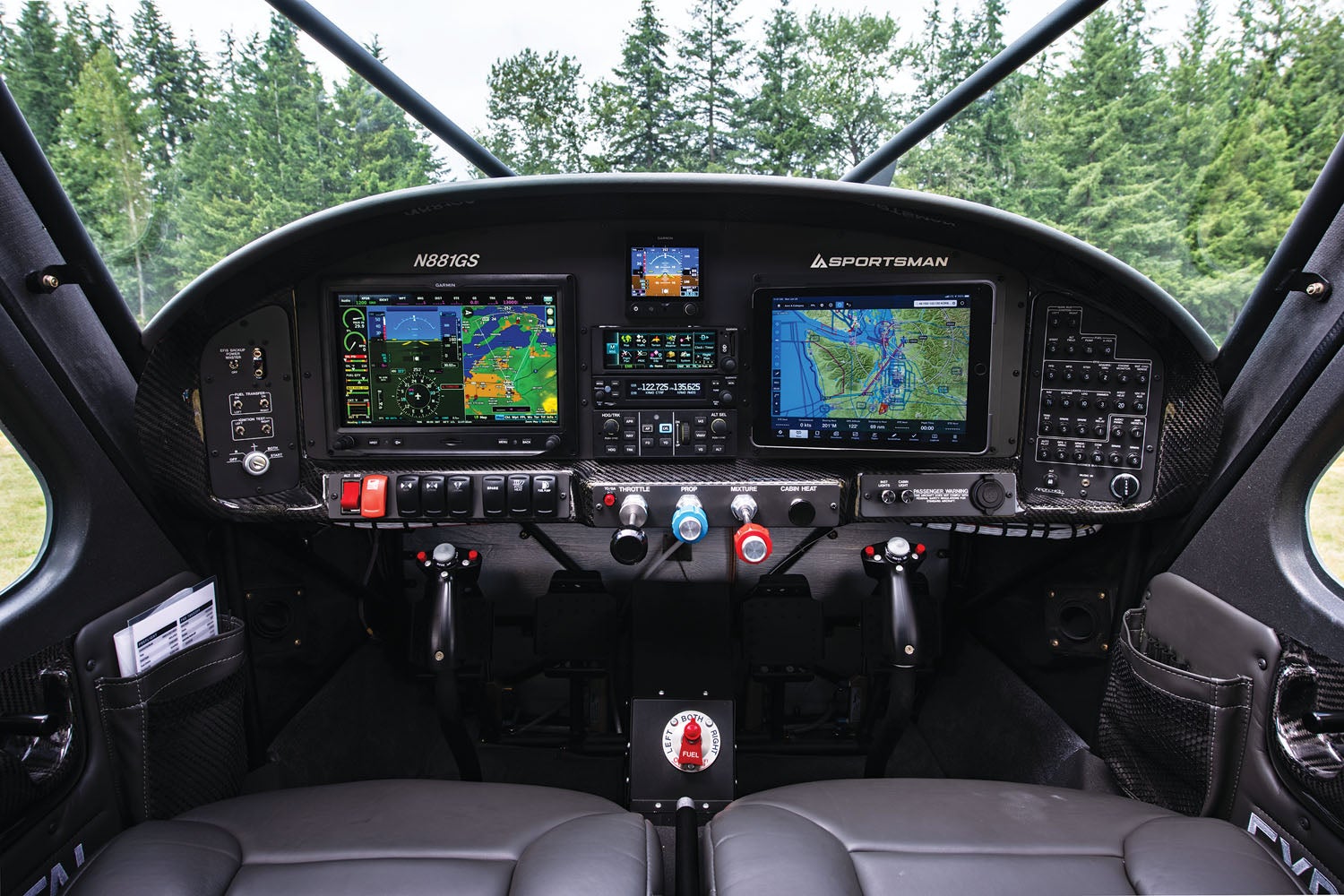
“Boat-style” rocker switches below the main EFIS handle the systems, with a small subpanel to the left with the ignition key, P-Mag electronic ignition switches and toggles for fuel transfer from the outboard auxiliary tanks to the inboard mains. This layout is cleanly laid out and easy to use. For the most part, it conforms to concepts familiar to those coming from certified aircraft, so that it’s likely the biggest challenge will be recalibrating from a yoke or a side stick to a center control stick. (Which, if you have a pulse, takes about 10 minutes.)
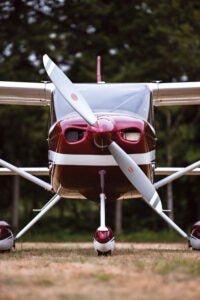
So Let’s Go
In all the important ways, the modern Sportsman is a conventional light aircraft. Start the big Lycoming through the usual procedures for an injected engine, get the avionics going and head for the runway. I’m not sure exactly why, but the new Sportsman feels really solid, the free-castering nosewheel tracking the taxiway without a lot of attention—on an admittedly near-calm day—and the big rudder doing most of the work pointing the airplane’s nose. Runup is about like you’d have in, say, a Skylane except for all the glass and the need to check that each P-Mag runs on its internal power. Set the trim with the hat switch on the stick, pop in a notch of flaps via the lever between the seats and you’re ready to go. (Lervold asked me if I thought the airplane should get electric flaps. Being old-school myself, I glared over my readers with a “don’t touch that” look and he just nodded.)

Thanks to having most of the options on board for a tricycle-gear version (including a detailed paint job), this Sportsman weighs 1525 pounds empty. Maximum gross is 2500 with the carbon-fiber fuselage option (2350 without); with the main tanks full (30 gallons) and Randy and me on board, we were about 435 pounds under max gross. Filling the aux tanks (for a total of 50 gallons), would leave about 315 pounds for baggage and passengers.
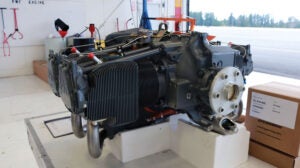
The IO-390-powered Sportsman has always been good on the runway, accelerating quickly to the 50-ish-knot rotation speed, climbing strongly at max power and going uphill at better than 1000 feet per minute in cruise climb of around 90-95 knots indicated. (Best-rate airspeed is 85 KIAS, which provides 1200 fpm at gross.) Overall, the Sportsman likes a little less deck angle for visibility and engine cooling, but it has the performance to give up. Cruise performance on the IO-390 is 143-145 knots true at 8000 feet density altitude on 11.5 gph rich of peak EGT—go lean of peak and just under 9 gph, and you’ll see right around 140 KTAS.
Handling Up There, Down Here
Don’t you hate it when pilots describe an airplane as “honest”? It sounds like a cop-out, a crutch when you can’t say anything more detailed about the thing. Problem is, that term perfectly describes the Sportsman. It has very good longitudinal stability—meaning it stays on trimmed airspeed without much attention—it has good yaw stability, which is good for turbulence. It’s maybe as yaw stable as a Skylane in the bumps, but it is good and doesn’t do that corkscrew deal in turbulence like your friend’s Bonanza. The Sportsman, like the GlaStar before it, has rightly been criticized for heavy roll effort, and even though the latter Sportsman aircraft have had servo tabs fitted to one aileron (the other wears roll trim), the design comes nowhere close to that two-finger responsiveness you get in a Van’s. Then again, it’s also a utility/travel airplane, and you’ll only really scrunch your nose if you’ve been flying RV-8s for the last few years; most pilots coming from certified iron will deem the Sportsman to be light and responsive.
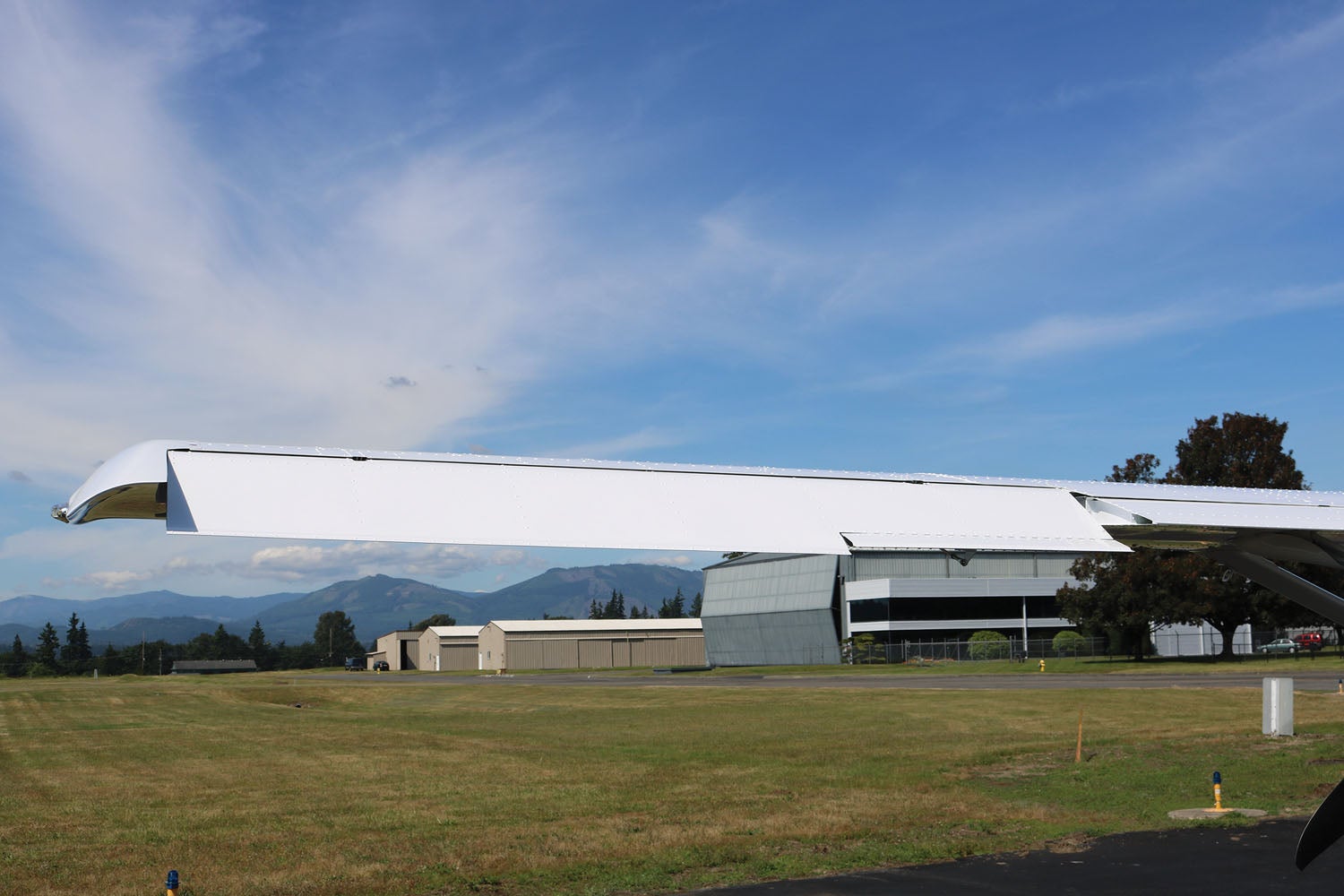
Lervold and I meandered over from the Arlington, Washington, base to the Orcas Island Airport for a few touch and goes, and it all came back to me. Speeds are higher than for my lighter GlaStar but still moderate. Plan on 60-65 KIAS down final with full flaps and a short rollout. The heavier Sportsman, with a 74-inch constant-speed prop, sheds energy quickly at idle power, which is a nice thing. It also accelerates briskly, even with full flaps. All the sightlines are good in the trike—and even very good as a taildragger—though it took me a few minutes to become accustomed to the seating position and taller/deeper glareshield. Together with the new dark color for the steel-tube cage, the new Sportsman felt less “open” than my own low-panel GlaStar and even than my old Sportsman. But memory is terribly fallible.
The Debrief
Lervold and I spent a bit of time after the flight talking about the next steps for the company, though he was careful not to let on too much. First off, the company can’t continue to offer its Two Weeks to Taxi program as long as social distancing is still a thing. He also feels that over the last few years not enough effort was put into some engineering aspects of the design, and he wants to take time during the pause to work on detail improvements.
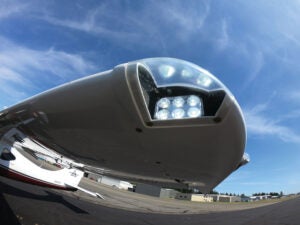
But there’s more, and here I’ll offer my take on what the Sportsman needs to be more desirable. First off, I think there’s some cruise speed to be found. Overall it’s a clean airplane with a reasonable, 133 square-feet of wing. We’re not in Cub category here, so all else being equal, there should be some more velocity in the design. It’s not a completely fair comparison, but the Van’s RV-14A, with the same engine and only slightly less wing area (126 square feet), is at least 25 knots faster. It is, however, some 500 pounds lighter and has only two seats. My point is that the Sportsman needs to trim that gap.
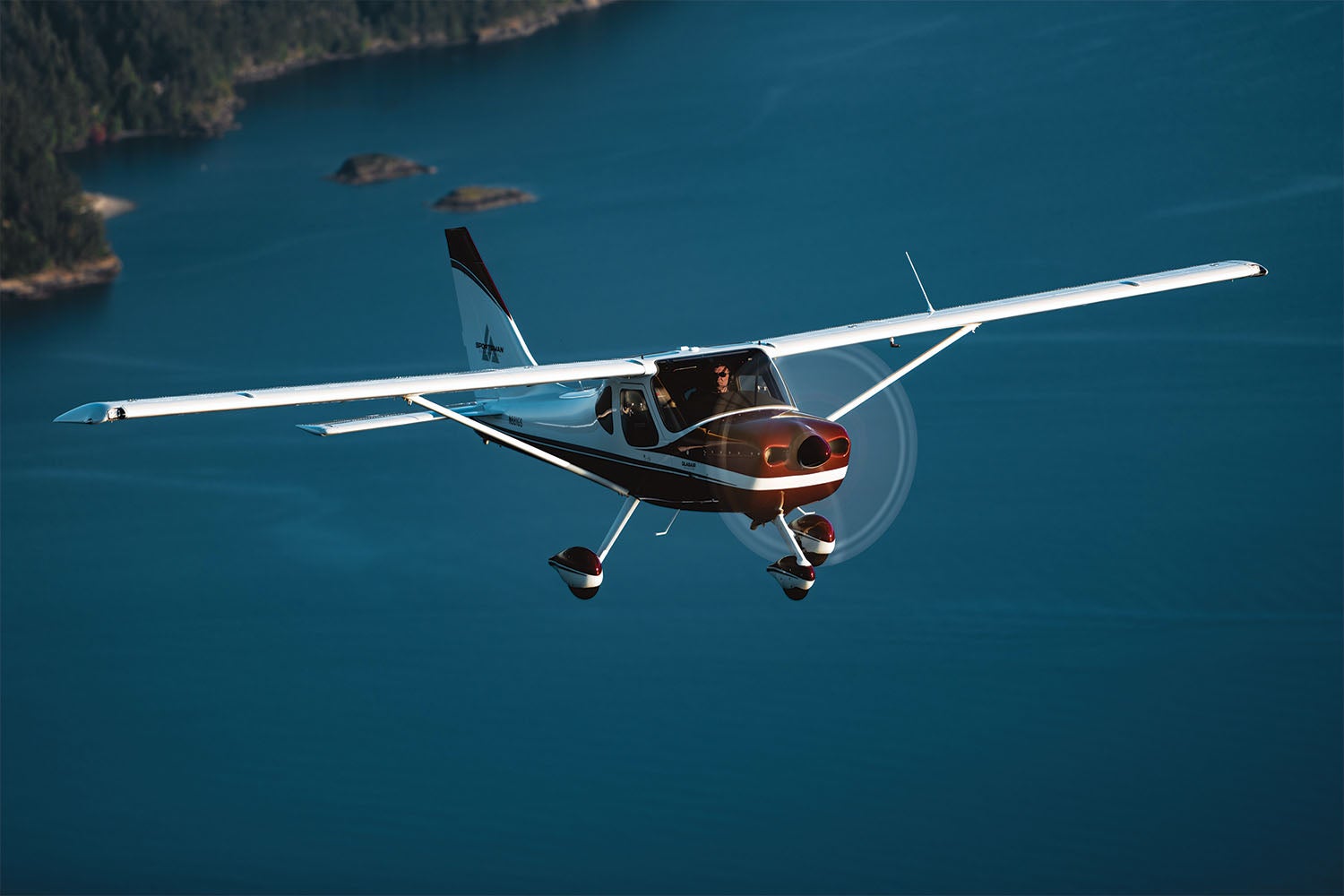 Speed losses mount quickly from both induced drag and drag from cooling. The IO-390 uses oil squirted to the undersides of the pistons for cooling and that taxes the oil cooler. One solution has been to open up the system and fit larger coolers. But I think the airplane would benefit from a disciplined engineering effort to improve cooling and reduce drag. This is not quick work but it pays off in the end. Think of what Roy LoPresti did for the Mooney airframe back in the 1970s; the dowdy M20F became the sleek and substantially faster 201. Oh, and there is the IO-390-C variant that offers a rated 215 hp.
Speed losses mount quickly from both induced drag and drag from cooling. The IO-390 uses oil squirted to the undersides of the pistons for cooling and that taxes the oil cooler. One solution has been to open up the system and fit larger coolers. But I think the airplane would benefit from a disciplined engineering effort to improve cooling and reduce drag. This is not quick work but it pays off in the end. Think of what Roy LoPresti did for the Mooney airframe back in the 1970s; the dowdy M20F became the sleek and substantially faster 201. Oh, and there is the IO-390-C variant that offers a rated 215 hp.
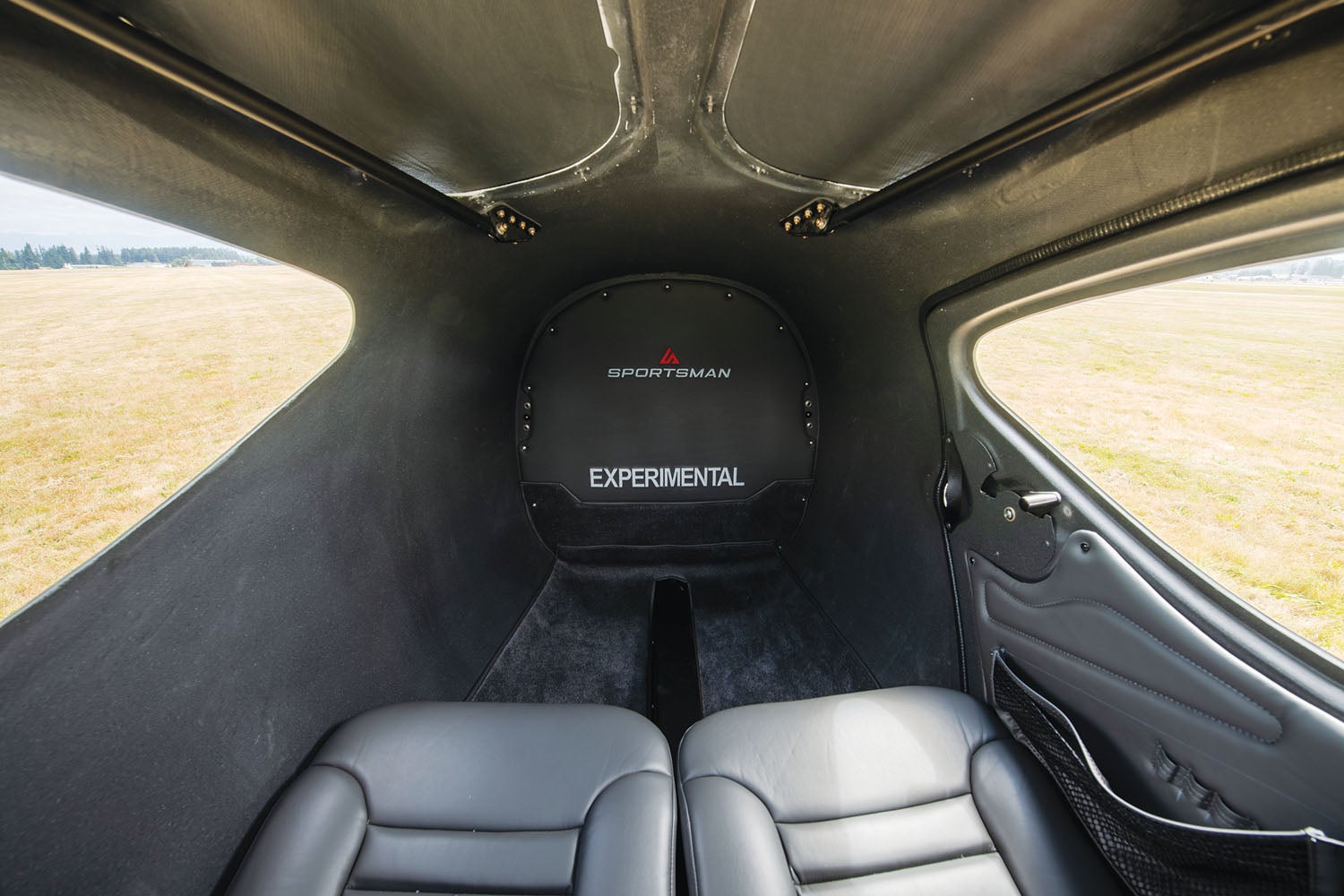
I would also raise my hand for more fuel capacity. Currently, the Sportsman has 50 gallons spread across four tanks, an artifact of the GlaStar design; these are aluminum tanks carried inside the wing structure. I was the first to use the IO-390 in the Sportsman, and while my Barrett-built engine appears to have been more efficient than the out-of-the-box Lycoming, I still had missions where 50 gallons just wasn’t enough. I would love to see 60 gallons on board, preferably in only two tanks so fuel management is simplified—you’d have five hours with an hour’s reserve at most cruise settings.
For passenger comfort, I’d love to see the rear cabin “poofed out” just a bit for more passenger room. The rear-facing seats in the second row are a big help to get passengers into the bigger part of the cone—and give them a better view of the outdoors—but you can’t really compare the back end of the Sportsman to a Cessna 182. Or even a 172. I would also move away from the folding wing and gain back some structural weight lost to the design. But both of these projects—a new cage and a new fuselage shell—are probably not in the cards if they want to restart production in 2021.
That said, I was impressed with the current iteration of the airplane. Many of the details left to early builders and TWTT participants have been dealt with, and the quality of the finished product is very good. Now it’s up to Lervold and company to stop and assess what can be done with the design and implement those changes. The production pause allows them to concentrate on development.
If events such as worsening U.S./China economics (since the company is Chinese owned) and a prolonged pandemic mean that Glasair Aviation does not come back from this strategic pause, it’ll be a legit shame: The Sportsman really deserves to live on.
Photos: Chris Cram and Marc Cook.

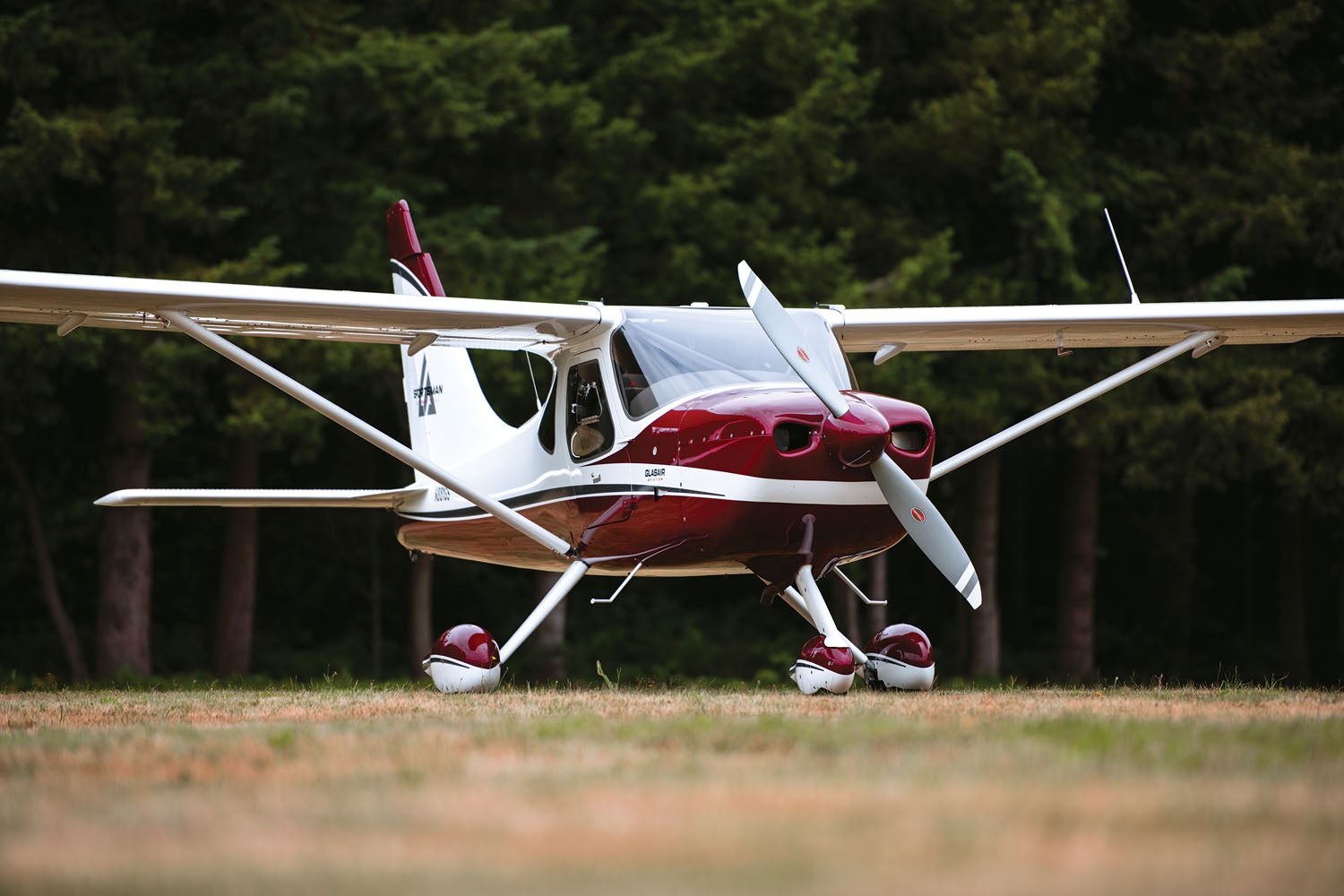
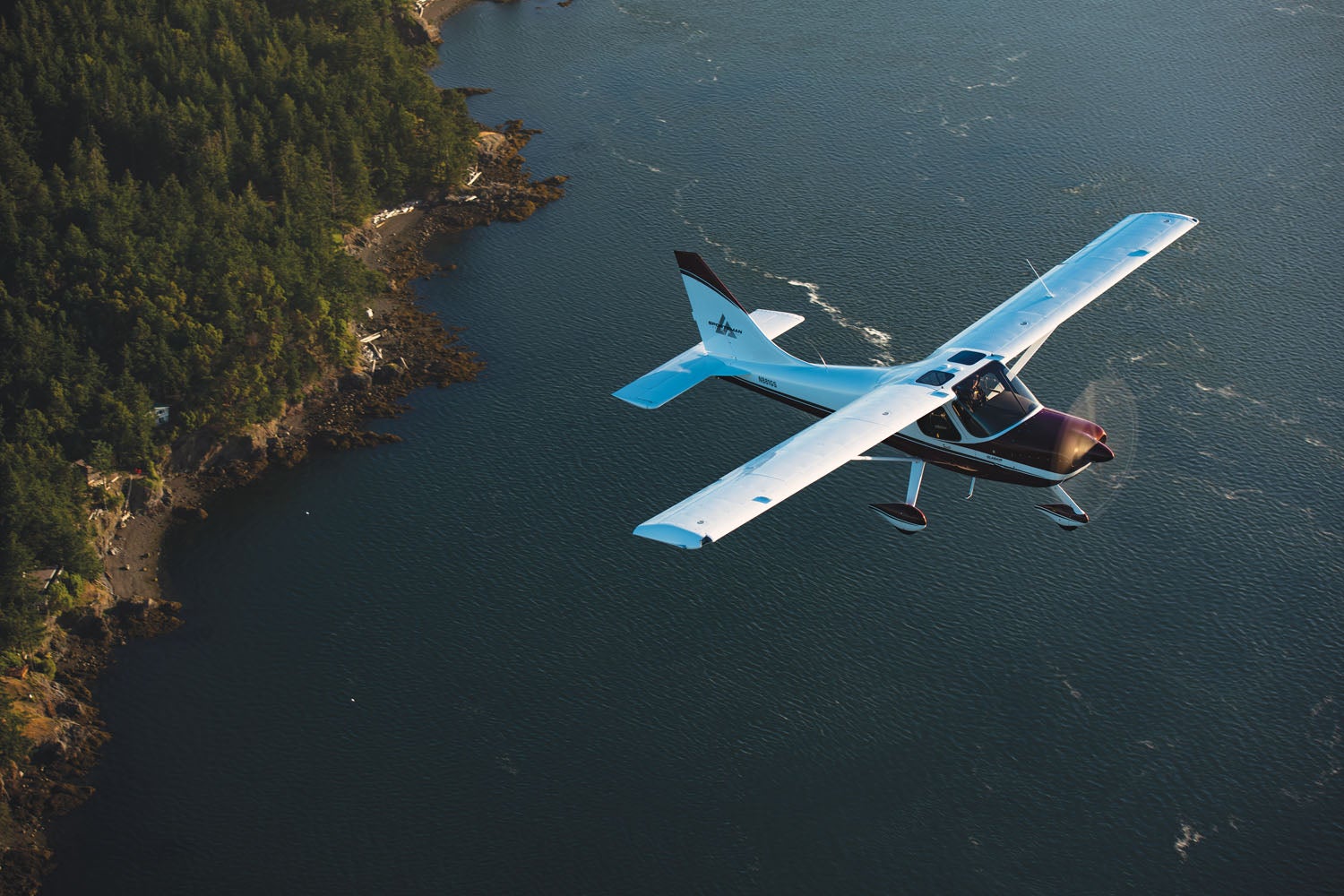
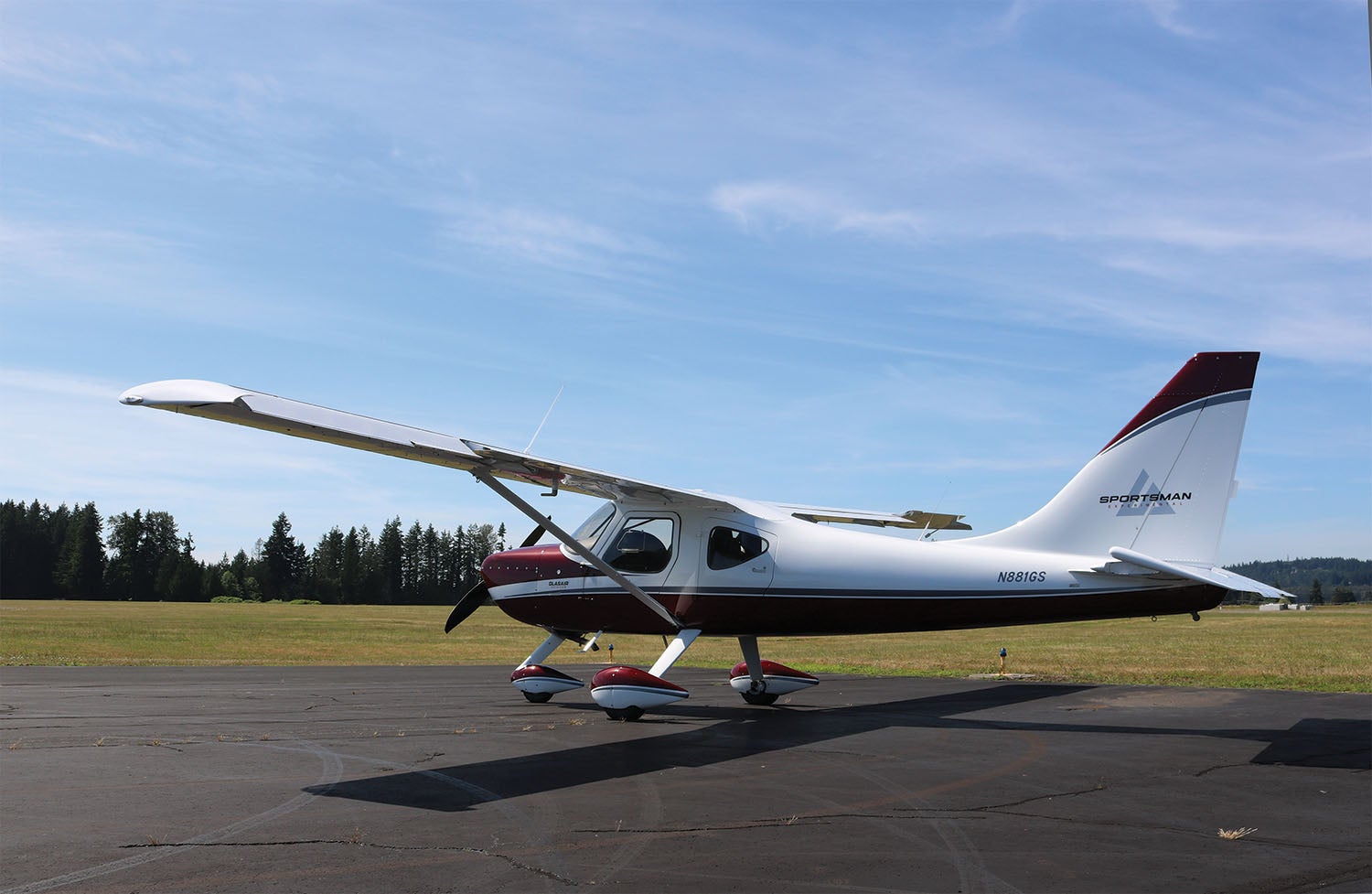













The Sportsman is a great aircraft!
The need for a cruise speed increase is certainly there and can be achieved.
More fuel for sure!
Liquid cooled system needs to be engineered,, giving several engine options.
A better diesel engine option such as the Deltahawk or Higgs Diesel.
As well; the liquid cooled “Lycoming” cylinder option would add efficiency.
I would agree that more engine options would be better, Brian. But I believe that Glasair Aviation will focus on using known, familiar engines for the short term. Developing a new FWF package is expensive and time consuming and, so far, the return on investment hasn’t been there for kit companies. Heck, it’s not even materialized for the big players outside of, say, Diamond.
The 3200cc ( 195 cu in ) engine from Adept engineering is a 120 degree V6 with 280hp , 585 ft lbs at 5500 rpm with a built in gearbox dropping propeller speed down to 2700 rpm .
It is liquid cooled , has fuel injection , DOHC with 4 valves per cylinder , is a good deal lighter than the equivalent Lycoming / Continental and much more fuel efficient as an added bonus . There is also a turbo version with 320 hp and 780 ft lbs .
TBO on both is 2500 hours .
I have been directly involved in the technical side of motorcycle motorsport , over the years I have seen the evolution from old technology to the very latest high technology , getting involved in the aero side a few years ago I was stumped at the very old technology and low efficiency levels of the aero engines out in the market and I could never get an honest answer out of anyone as to the reasons therefore . So it was a pleasant surprise to find Adept practically on my doorstep and manufacturing an engine that made sense to me .
On the Aero Diesel side. Are there plans to put the larger CD-170 into the airframe or even another manufacturers Diesel engine with up to 220 Hp or so?
Thanks you.
Hi, Bo. Not at this time. The company’s short-term focus is to improve the airplane with existing gas engines and then see what happens beyond that. The Jet A-burning engine has not had success in the US market; it would be more of a global program and that’s a bit beyond Glasair Aviation’s immediate concerns.
One of the reasons that the takeup for the diesel was so low was that the upcharge was insane – 80k USD , this was obviosuly exhorbitant.
This was 80k over the 180hp engine, even people who spend over 200k on a glasair for personal flying ( a very questionable economic decision) will question that number,